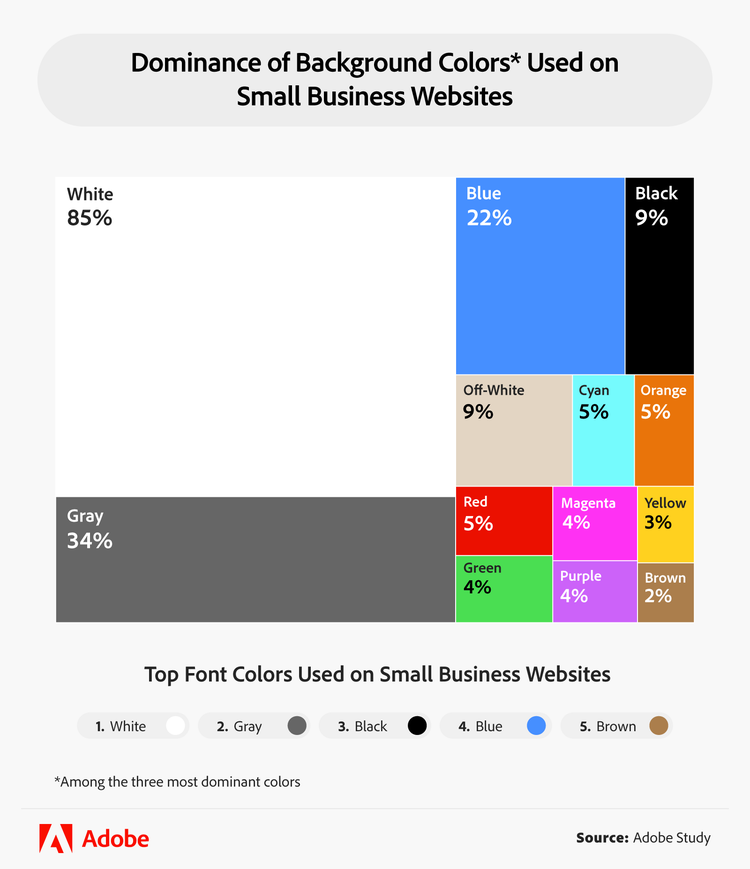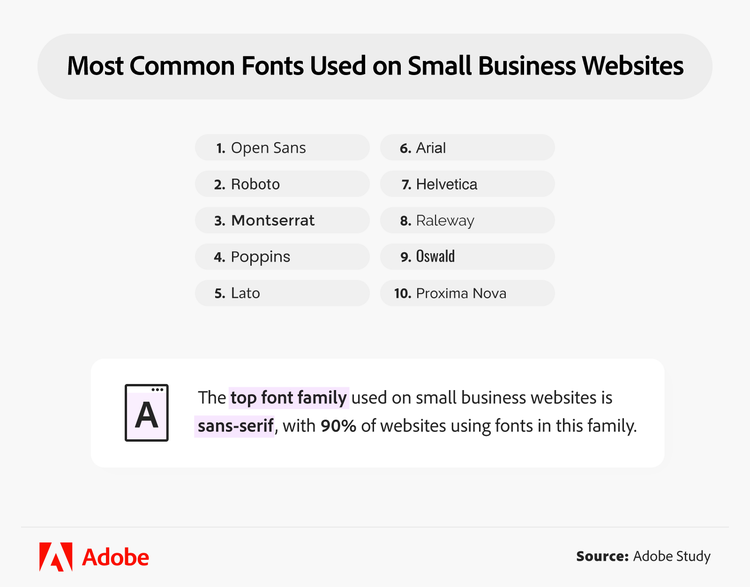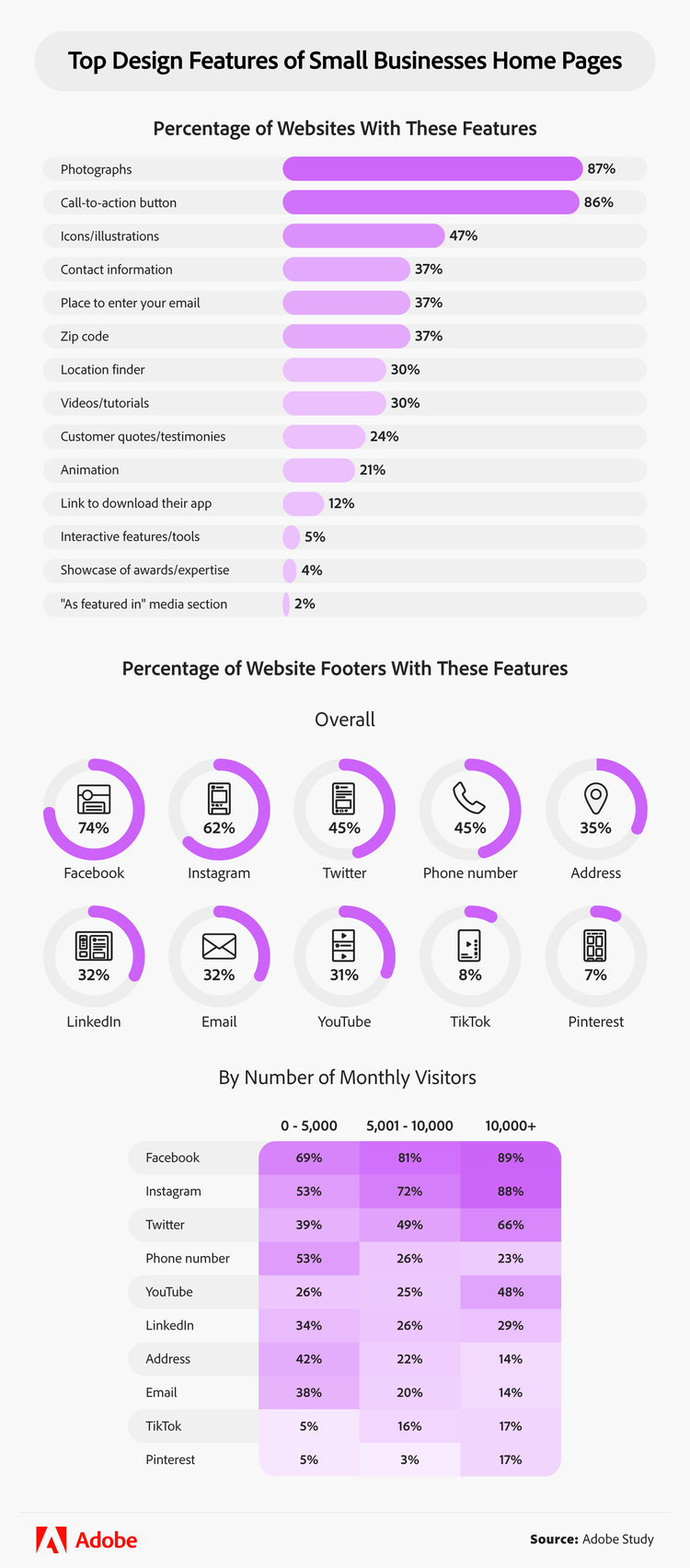2024 Small business branding report: Colors, fonts & websites must-haves

Our 2024 Small Business Branding Report is your compass to help navigate the latest online branding trends. For this report, we analyzed the design of 930 small business websites to uncover the dominant trends in colors, typography, and features. Using tools like the ColorPick Eyedropper and WhatFont extensions, we meticulously examined these websites to understand what makes a small business’s online presence stand out.
Whether you’re looking to revamp your website or just starting the process, we hope these insights inspire and guide you in making informed decisions that resonate with your brand identity and connect with your audience.
Key takeaways
- The top background colors for small business websites are white, gray, and blue.
- The top font used on small business websites is Open Sans.
- 74% of small businesses have their Facebook account listed in their website’s footer, while 62% list their Instagram.
- High traffic websites are 66% more likely than low traffic ones to have their Instagram on their footer and nearly 30% more likely to have their Facebook there, too.
Summary/Overview
Small business colors of the year
In small business branding, the choice of website design elements speaks volumes about a brand’s identity and appeal to consumers. To begin our study, we examined how businesses use color to create their digital persona.

Our analysis of business websites revealed a preference for neutral background colors. The top choices were white, blue, and gray, reflecting a trend toward clean, professional, and versatile backdrops. Equally telling is the choice of font colors. The predominance of white, gray, and black for text demonstrates a universal approach to ensuring readability and elegance based in minimalism.
Not all businesses stuck to neutrals, though — some opted for brighter colors. Understanding color contrast is key for those looking to infuse more vibrancy into their websites. When selecting brighter or more saturated background colors, choose text colors for optimal readability. This often means using lighter text on darker backgrounds or vice versa.
High contrast not only enhances readability but also contributes to website accessibility, ensuring that content is easily discernible for all users, including those with visual impairments.
Typography trends
As we looked closer at the elements shaping the digital face of today’s small businesses, the choice of typography also emerged as a significant factor in website design.

In our analysis of small business websites, the sans serif font family dominated, with 90% of websites opting for this clean and modern style. Serif fonts are characterized by small lines or decorative strokes often known as “feet” extending from the letters. Conversely, sans serif fonts lack these embellishments. Open Sans was the most popular font, followed closely by Roboto and Montserrat. This preference for sans serif fonts reflects a wider trend in digital design, where clarity and simplicity are most important.
However, remember the role of serif fonts. While they can add a touch of elegance and traditionalism to a website, their readability varies greatly depending on screen size and resolution. In contexts where reading comfort is crucial, such as lengthy blog posts or detailed product descriptions, serifs can aid readability by guiding the eye along the lines of text.
Conversely, serifs can sometimes render text less legible on smaller screens or in less optimal viewing conditions. Balancing aesthetic appeal and functional readability is a key consideration for small businesses aiming to cater to a diverse online audience.
Preferred website elements
The next layer of a website’s identity is its functional and social elements, which reflect its brand identity and are a major point of customer engagement.

Photographs were the most common feature, with 87% of small business websites incorporating them. Closely following were Call-to-action (CTA) buttons on 86% of sites, highlighting their pivotal role in guiding visitor interactions. Additionally, 47% of websites effectively used icons and illustrations, adding a layer of visual appeal and user-friendly navigation. Only 37% prominently displayed phone numbers or other contact information, suggesting a shift toward digital-first communication methods.
As for social media integration, links to Facebook pages led with a 74% presence in website footers, followed by Instagram at 62%. High traffic websites were 66% more likely than low traffic ones to have their Instagram on their footer and nearly 30% more likely to have their Facebook there. This correlation highlights the importance of social media in driving website traffic and enhancing online presence.
Websites in 2024
Our study highlighted key trends in website design for certain colors, fonts, and features. Dominant background colors like white, blue, and gray, coupled with popular sans serif fonts such as Open Sans, Roboto, and Montserrat, show a preference for clarity and modernity on today’s small business websites.
The significant use of photographs, CTAs, and social media links, particularly to Facebook and Instagram, underline the importance of visual engagement and digital connectivity. As small business owners navigate the always changing digital world, incorporating these insights may prove invaluable for enhancing their online presence and customer engagement.
Methodology
Using the SBA Franchise Directory, we sourced data from 930 small businesses to explore small business website design trends, such as dominant colors, fonts used, functional features, and more. We used the ColorPick Eyedropper extension to get the hex codes of colors and the WhatFont extension to get the fonts. Different shades were grouped as their main color (for example, we grouped light and dark green as “green”). We then used Ahrefs to analyze the traffic of each website and used that data while comparing the trends of high and low traffic sites.
Fair use statement
We encourage readers to share the insights and information from our 2024 Small Business Branding Report for noncommercial purposes, but please remember to credit and link back to this page for any use of the material.





